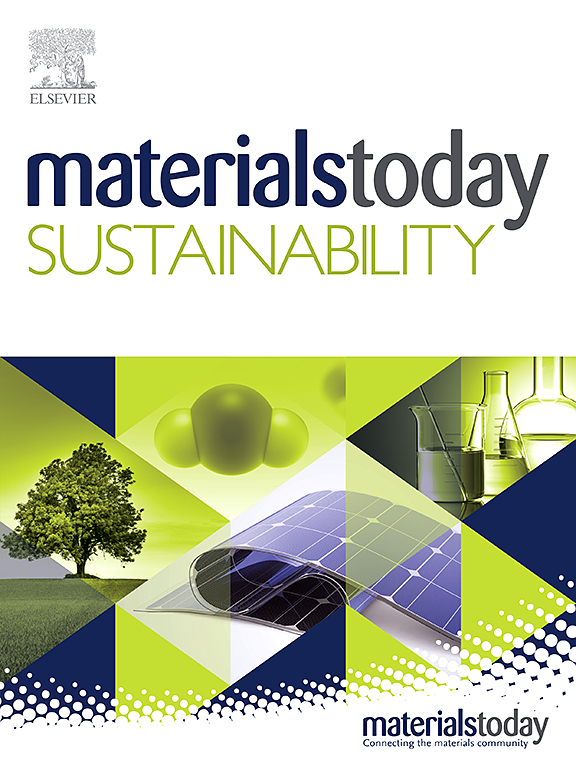用于均匀分散高岭土纳米管以提高胶凝复合材料微观和宏观性能的黄原胶生物聚合物:化学表面活性剂的可持续替代品
IF 7.1
3区 材料科学
Q1 GREEN & SUSTAINABLE SCIENCE & TECHNOLOGY
引用次数: 0
摘要
为了充分利用高岭土纳米管在水泥基复合材料中的潜力,在水泥环境中稳定的分散是必不可少的。虽然聚羧酸醚(PCE)通常用于此目的,但黄原胶(XG)生物聚合物提供了更环保的选择,提供稳定和均匀的分散。xg修饰的HNTs在增强这些复合材料的工程性能方面表现出了希望,但它们对微观和宏观特性的影响尚不清楚。本研究综合评估了xg改性HNTs对胶凝材料水化相组合、孔隙结构、微观结构形态、抗压强度和输运性能的影响,并将这些结果与类似体系中pce改性HNTs进行了比较。结果表明,通过降低氢氧化钙(CH)含量和细化CH晶体结构,xg修饰的HNTs明显优于pce修饰的HNTs。此外,xg改性的HNTs更有效地加速了水泥的水化,促进了凝胶结构的形成。重要的是,与pce修饰的HNTs相比,xg修饰的HNTs有助于更大程度地减小孔径和孔隙度,使孔隙分布更均匀,并形成更均匀的胶凝基质。此外,90天后,与HNT-PCE混合物相比,HNT-XG混合物的抗压强度(14.3%)、超声脉冲速度(7.1%)和电阻率(13.3%)均有所提高。最后,可持续性评估显示,与PCE相比,使用XG生物聚合物的能耗降低48.6%,生产过程清洁度降低89.4%,生产成本降低16.3%,因此,XG生物聚合物可以被认为是化学表面活性剂(如PCE)在胶凝体系中均匀分散HNTs的优越且可持续的替代品。本文章由计算机程序翻译,如有差异,请以英文原文为准。

Xanthan gum biopolymer for uniform dispersion of halloysite nanotubes to enhance micro- and macroscopic performance of cementitious composite: A sustainable alternative to chemical surfactants
To fully exploit the potential of halloysite nanotubes (HNTs) in cement-based composites, stable dispersion in cementitious environments is essential. While polycarboxylate ether (PCE) is commonly used for this purpose, xanthan gum (XG) biopolymer offers a greener alternative, providing stable and uniform dispersion. XG-modified HNTs show promise in enhancing the engineering properties of these composites, but their impact on micro- and macroscopic characteristics is still unclear. This study comprehensively assessed the influence of XG-modified HNTs on hydration-phase assemblage, pore structure, microstructural morphology, as well as compressive strength and transport properties in cementitious materials, and compared these results to PCE-modified HNTs in similar systems. The results demonstrated that XG-modified HNTs significantly outperformed PCE-modified HNTs by reducing calcium hydroxide (CH) content and refining CH crystal structures. Additionally, XG-modified HNTs accelerated cement hydration more effectively and promoted enhanced gel structure formation. Importantly, XG-modified HNTs contributed to a greater reduction in pore size and porosity, a more uniform pore distribution, and the formation of a more homogeneous cementitious matrix compared to PCE-modified HNTs. Furthermore, after 90 days, the HNT-XG mixture exhibited increases in compressive strength (14.3%), ultrasonic pulse velocity (7.1%), and electrical resistivity (13.3%) compared to the HNT-PCE mixture. Finally, the sustainability assessment revealed that using XG biopolymer results in 48.6% lower energy consumption, an 89.4% cleaner production process, and 16.3% lower production costs compared to PCE. Consequently, XG biopolymer can be considered a superior and sustainable alternative to chemical surfactants like PCE for the uniform dispersion of HNTs in cementitious systems.
求助全文
通过发布文献求助,成功后即可免费获取论文全文。
去求助
来源期刊

Materials Today Sustainability
Multiple-
CiteScore
5.80
自引率
6.40%
发文量
174
审稿时长
32 days
期刊介绍:
Materials Today Sustainability is a multi-disciplinary journal covering all aspects of sustainability through materials science.
With a rapidly increasing population with growing demands, materials science has emerged as a critical discipline toward protecting of the environment and ensuring the long term survival of future generations.
 求助内容:
求助内容: 应助结果提醒方式:
应助结果提醒方式:


